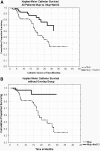Topical mupirocin/sodium hypochlorite reduces peritonitis and exit-site infection rates in children
- PMID: 19820132
- PMCID: PMC2798867
- DOI: 10.2215/CJN.02770409
Topical mupirocin/sodium hypochlorite reduces peritonitis and exit-site infection rates in children
Abstract
Background and objectives: Peritoneal dialysis (PD) is a common maintenance renal replacement modality for children with ESRD frequently compromised by infectious peritonitis and catheter exit site and tunnel infections (ESI/TI). The effect of topical mupirocin (Mup) and sodium hypochlorite (NaOCl) solution was evaluated as part of routine daily exit site care on peritonitis and ESI/TI rates, causative microorganisms, and catheter survival rates.
Design, setting, participants, & measurements: Retrospective chart review of children on home continuous cycling PD between April 1, 2001 and June 30, 2007 was performed. Infection rates were examined based on exit site protocol used in two different periods: Mup alone, April 1, 2001 to November 17, 2004; and Mup and NaOCl (Mup+NaOCl), November 18, 2004 to June 30, 2007.
Results: Eighty-three patients (mean PD initiation age: 12.1 +/- 5.8 yr) received home PD over 2009 patient months. Annualized rates (ARs) for peritonitis decreased from 1.2 in the Mup period to 0.26 in the Mup+NaOCl period (P < 0.0001). ARs for ESI/TI decreased from 1.36 in the Mup period to 0.33 in the Mup+NaOCl period (P < 0.0001). No infections with Mup-resistant organisms were observed when either Mup or Mup+NaOCl was used for prophylaxis. Gram-negative-organism associated peritonitis decreased from an AR of 0.31 in the Mup period to 0.07 in the Mup+NaOCl period (P < 0.001). Infection-related catheter removal rates decreased from 1 in 38.9 catheter-months in the Mup period to 1 in 94.2 in the Mup+NaOCl period (P = 0.01). Catheter survival rates were longer in the Mup+NaOCl period (Kaplan-Meier, P < 0.009).
Conclusions: The combination Mup+NaOCl in daily exit site care was very effective to reduce PD catheter-associated infections and prolong catheter survival in pediatric patients.
Figures



Comment in
-
Concerns regarding routine use of sodium hypochlorite for exit-site care--what about the risks of encapsulating peritoneal sclerosis?Perit Dial Int. 2010 Jul-Aug;30(4):480. doi: 10.3747/pdi.2009.00261. Perit Dial Int. 2010. PMID: 20628114 No abstract available.
Similar articles
-
Dialysis: The importance of peritoneal catheter exit-site care.Nat Rev Nephrol. 2010 May;6(5):259-60. doi: 10.1038/nrneph.2010.45. Nat Rev Nephrol. 2010. PMID: 20424630 No abstract available.
-
Comparison of Topical Chlorhexidine and Mupirocin for the Prevention of Exit-Site Infection in Incident Peritoneal Dialysis Patients.Perit Dial Int. 2017 May-Jun;37(3):266-272. doi: 10.3747/pdi.2016.00257. Epub 2017 Feb 9. Perit Dial Int. 2017. PMID: 28183858
-
Alternating Mupirocin/Gentamicin is Associated with Increased Risk of Fungal Peritonitis as Compared with Gentamicin Alone - Results of a Randomized Open-Label Controlled Trial.Perit Dial Int. 2016 May-Jun;36(3):340-6. doi: 10.3747/pdi.2015.00237. Epub 2016 Apr 4. Perit Dial Int. 2016. PMID: 27044796 Free PMC article. Clinical Trial.
-
Effect of preventing Staphylococcus aureus carriage on rates of peritoneal catheter-related staphylococcal infections. Literature synthesis.Perit Dial Int. 2001 Sep-Oct;21(5):471-9. Perit Dial Int. 2001. PMID: 11757831 Review.
-
Epidemiology, management, and prevention of exit site infections in peritoneal dialysis patients.Ther Apher Dial. 2022 Apr;26(2):275-287. doi: 10.1111/1744-9987.13726. Epub 2021 Sep 7. Ther Apher Dial. 2022. PMID: 34435734 Review.
Cited by
-
Readmission within 30 days of hospital discharge among children receiving chronic dialysis.Clin J Am Soc Nephrol. 2014 Mar;9(3):536-42. doi: 10.2215/CJN.05410513. Epub 2014 Feb 7. Clin J Am Soc Nephrol. 2014. PMID: 24509294 Free PMC article.
-
Peritoneal dialysis-related infections recommendations: 2016 update. What is new?Int Urol Nephrol. 2017 Dec;49(12):2177-2184. doi: 10.1007/s11255-017-1632-9. Epub 2017 Jun 1. Int Urol Nephrol. 2017. PMID: 28573488 Review.
-
Epidemiology and outcomes of peritonitis in children on peritoneal dialysis in Australasia.Pediatr Nephrol. 2010 Sep;25(9):1739-45. doi: 10.1007/s00467-010-1510-5. Pediatr Nephrol. 2010. PMID: 20393751
-
A randomized controlled trial comparing mupirocin and polysporin triple ointments in peritoneal dialysis patients: the MP3 Study.Clin J Am Soc Nephrol. 2012 Feb;7(2):297-303. doi: 10.2215/CJN.07970811. Epub 2011 Dec 1. Clin J Am Soc Nephrol. 2012. PMID: 22134627 Free PMC article. Clinical Trial.
-
ISPD Peritonitis Recommendations: 2016 Update on Prevention and Treatment.Perit Dial Int. 2016 Sep 10;36(5):481-508. doi: 10.3747/pdi.2016.00078. Epub 2016 Jun 9. Perit Dial Int. 2016. PMID: 27282851 Free PMC article. Review. No abstract available.
References
-
- Collins AJ, Kasiske B, Herzog C, Chavers B, Foley R, Gilbertson D, Grimm R, Liu J, Louis T, Manning W, McBean M, Murray A, St Peter W, Xue J, Fan Q, Guo H, Li Q, Li S, Qiu Y, Li S, Roberts T, Skeans M, Snyder J, Solid C, Wang C, Weinhandl E, Zhang R, Arko C, Chen SC, Dalleska F, Daniels F, Dunning S, Ebben J, Frazier E, Hanzlik C, Johnson R, Sheets D, Wang X, Forrest B, Berrini D, Constantini E, Everson S, Eggers P, Agodoa L: Excerpts from the United States Renal Data System 2006 Annual Data Report. Am J Kidney Dis 49[Suppl 2]: S1–S296, 2007 - PubMed
-
- Furth SL, Donaldson LA, Sullivan EK, Watkins SL: Peritoneal dialysis catheter infections and peritonitis in children: a report of the North American Pediatric Renal Transplant Cooperative Study. Pediatr Nephrol 15: 179–182, 2000 - PubMed
-
- Honda M: The 1997 Report of the Japanese National Registry data on pediatric peritoneal dialysis patients. Perit Dial Int 19[Suppl 2]: S473–S478, 1999 - PubMed
-
- Yinnon AM, Gabay D, Raveh D, Schlesinger Y, Slotki I, Attias D, Rudensky B: Comparison of peritoneal fluid culture results from adults and children undergoing CAPD. Perit Dial Int 19: 51–55, 1999 - PubMed
-
- Lerner GR, Warady BA, Sullivan EK, Alexander SR: Chronic dialysis in children and adolescents. The 1996 annual report of the North American Pediatric Renal Transplant Cooperative Study. Pediatr Nephrol 13: 404–417, 1999 - PubMed
MeSH terms
Substances
LinkOut - more resources
Full Text Sources
Medical
Research Materials
Miscellaneous

